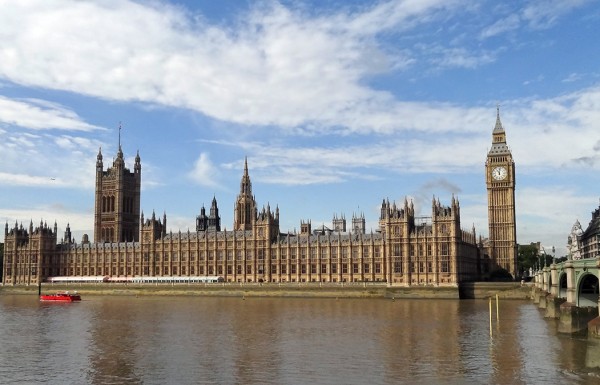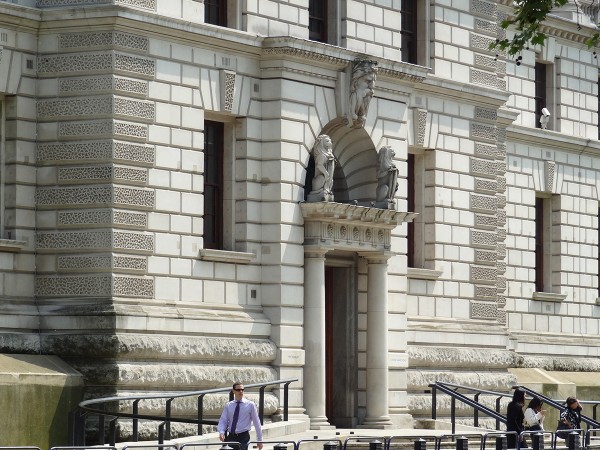The Autumn Statement about a long cold winter
 The Autumn Statement, delivered annually by the Chancellor of the Exchequer in late November or early December, is rather like a second Budget. In his statement, the Chancellor presents new forecasts for the UK economy by the Office for Budget Responsibility (OBR) and announces various policy changes in the light of the forecasts.
The Autumn Statement, delivered annually by the Chancellor of the Exchequer in late November or early December, is rather like a second Budget. In his statement, the Chancellor presents new forecasts for the UK economy by the Office for Budget Responsibility (OBR) and announces various policy changes in the light of the forecasts.
So what does this OBR say? Its headline reads, “Government borrowing revised higher as weaker economy hits revenues” and this is followed by the statement:
The OBR has revised up its forecasts for public-sector borrowing over the next five years, as a weaker outlook for the economy reduces tax revenues. As a result, the Government no longer seems likely to achieve its target of reducing public-sector net debt in 2015–16.
 The chart shows OBR forecasts for public-sector net borrowing made in June 2010 (its first forecast after the OBR was formed by the Coalition government), in March 2012 and in December 2012. The current forecast clearly shows borrowing set to decline more slowly than in the earlier forecasts. Click here for a PowerPoint of the chart. (Note that the effects of transferring the pension assets of the Royal Mail to the Treasury and the effects of not paying interest to the Bank of England on government bonds purchased under quantitative easing programmes have not been included in order to make the three forecasts consistent.)
The chart shows OBR forecasts for public-sector net borrowing made in June 2010 (its first forecast after the OBR was formed by the Coalition government), in March 2012 and in December 2012. The current forecast clearly shows borrowing set to decline more slowly than in the earlier forecasts. Click here for a PowerPoint of the chart. (Note that the effects of transferring the pension assets of the Royal Mail to the Treasury and the effects of not paying interest to the Bank of England on government bonds purchased under quantitative easing programmes have not been included in order to make the three forecasts consistent.)
So with a weaker economy and slower recovery than previously forecast, what are George Osborne’s options? He and his colleagues, along with various economists, argue for sticking to Plan A. This means continuing with austerity measures in order to get the public-sector deficit down. But with government borrowing having fallen more slowly than forecast, this means further government expenditure cuts, such as reductions in benefits, cuts in grants to local authorities and reductions in pensions relief. Even so, achieving his two targets – (1) eliminating the cyclically adjusted current (as opposed to capital) budget deficit by 2015/16 (the so-called ‘fiscal mandate’), and (2) public-sector debt falling as a proportion of GDP by 2015/16 – will both be missed. They were extended by a year in the Budget last March. They have now been extended by a further year to 2017/18.
The opposition and many other economists argue that Plan A has failed. Austerity has prevented the economy from growing and has thus meant a slower reduction in the deficit as tax revenues have not grown nearly as much as hoped for. A more expansionary policy would allow the deficit to be reduced more quickly, especially if extra government expenditure were focused on infrastructure and other capital spending.
 It could be argued that George Osborne’s Autumn Statement moves some way in this direction – a Plan A+. He is making deeper cuts in welfare and government departmental spending in order to divert monies into capital spending. For example, there will be £1bn of extra expenditure on roads; £1bn extra on schools; £270m on FE colleges; and £600m extra for scientific research. Also, by extending the period of austerity to 2017/18, this has meant that he has not had to make even deeper cuts. What is more, he is increasing income tax allowances and cutting the rate of corporation tax by 1% more than originally planned and scrapping the planned 3p per litre rise in road fuel duty. He hopes to make up any lost tax revenue from these measures by HMRC clamping down on tax evasion.
It could be argued that George Osborne’s Autumn Statement moves some way in this direction – a Plan A+. He is making deeper cuts in welfare and government departmental spending in order to divert monies into capital spending. For example, there will be £1bn of extra expenditure on roads; £1bn extra on schools; £270m on FE colleges; and £600m extra for scientific research. Also, by extending the period of austerity to 2017/18, this has meant that he has not had to make even deeper cuts. What is more, he is increasing income tax allowances and cutting the rate of corporation tax by 1% more than originally planned and scrapping the planned 3p per litre rise in road fuel duty. He hopes to make up any lost tax revenue from these measures by HMRC clamping down on tax evasion.
But by sticking to his broad austerity strategy, and with many parts of the global economy having weakened, it looks as if the UK economy is in for several more years of sluggish growth. Winter is going to be long.
Webcasts and Podcasts Autumn Statement: George Osborne scraps 3p fuel duty rise BBC News, Carole Walker (5/12/12)
Autumn Statement: George Osborne scraps 3p fuel duty rise BBC News, Carole Walker (5/12/12) Autumn Statement: OBR says deficit ‘shrinking more slowly’ BBC News, Robert Chote (5/12/12)
Autumn Statement: OBR says deficit ‘shrinking more slowly’ BBC News, Robert Chote (5/12/12) Autumn Statement: Headlines from George Osborne’s speech BBC News, Andrew Neil (5/12/12)
Autumn Statement: Headlines from George Osborne’s speech BBC News, Andrew Neil (5/12/12) Autumn Statement: Flanders, Robinson and Peston reactio BBC News, Stephanie Flanders, Nick Robinson and Robert Peston (5/12/12)
Autumn Statement: Flanders, Robinson and Peston reactio BBC News, Stephanie Flanders, Nick Robinson and Robert Peston (5/12/12) Boosting the British Budget CNN, Jim Boulden (5/12/12)
Boosting the British Budget CNN, Jim Boulden (5/12/12) Autumn statement 2012: key points – video analysis The Guardian, Larry Elliott, Jill Treanor, Patrick Collinson and Damian Carrington (5/12/12)
Autumn statement 2012: key points – video analysis The Guardian, Larry Elliott, Jill Treanor, Patrick Collinson and Damian Carrington (5/12/12)
Articles
Autumn Statement 2012: the full speech The Telegraph (5/12/12)
Autumn Statement: Benefit squeeze as economy slows BBC News (5/12/12)
Autumn Statement: At-a-glance summary of key points BBC News (5/12/12/)
Austerity to last until 2018, admits George Osborne Independent, Oliver Wright
Autumn statement: George Osborne reveals benefits cut Channel 4 News (5/12/12/)
Autumn Statement 2012: Cut welfare, create jobs – a very Tory statement The Telegraph, Damian Reece (5/12/12)
Autumn statement 2012: economy weaker than expected, Osborne says The Guardian, Heather Stewart (5/12/12)
Analysis: Even the ‘autumn’ bit seemed optimistic BBC News, Chris Mason (5/12/12)
George Osborne’s autumn statement 2012: reaction The Guardian, Julia Kollewe (5/12/12)
Candid Osborne avoids political risk Financial Times, Janan Ganesh (5/12/12)
Autumn statement: Why George Osborne’s Budget won’t be a game changer The Telegraph, Allister Heath (4/12/12/)
Autumn statement 2012: expert verdict The Guardian, Richard Murphy, Dominic Raab, Ann Pettifor, Gavin Kelly, Prateek Buch and Mark Serwotka (5/12/12/)
The alternative autumn statement Channel 4 News (5/12/12)
Autumn Statement 2012: man cannot live by deficit reduction alone The Telegraph, Roger Bootle (5/12/12)
Autumn statement: cuts are just a sideshow The Guardian, John Redwood (5/12/12)
What does the Autumn Statement mean for business? Economia, David Mellor (5/12/12)
Autumn Statement Reaction: UK AAA ‘safe for today’ Investment Week (5/12/12)
Autumn Statement: A wintry statement of reality BBC News, Stephanie Flanders (4/12/12)
What has changed? BBC News, Stephanie Flanders (6/12/12)
UK warned on debt ‘credibility’ over AAA rating BBC News (5/12/12)
Data
Autumn statement 2012 in charts The Guardian, Simon Rogers (5/12/12/)
Who suffers most from Britain’s austerity? How the figures stack up The Guardian, Tom Clark (5/12/12)
Economic and fiscal outlook charts and tables – December 2012 OBR (5/12/12)
Economic and fiscal outlook supplementary economy tables – December 2012 OBR (5/12/12)
Forecasts for the UK economy HM-Treasury
OBR, Treasury and IFS links
Economic and fiscal outlook – December 2012 OBR (5/12/12)
Autumn Statement 2012 HM Treasury (5/12/12)
Autumn Statement 2012 IFS
Questions
- Distinguish between ‘stocks’ and ‘flows’. Define (a) public-sector net borrowing (PSNB) and (b) the public-sector net debt (PSND) and explain whether each one is a stock or a flow.
- Summarise the measures announced by George Osborne in his Autumn Statement.
- What are his arguments for not adopting a more expansionary fiscal policy?
- Assess his arguments.
- What is meant by the ‘output gap’? What are the OBR’s forecasts about the output gap and what are the implications?
- How has quantitative easing affected PSNB and PSND?
- Distinguish between the cyclical and structural deficit. What implications does this distinction have for fiscal policy?